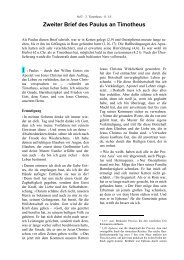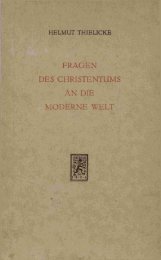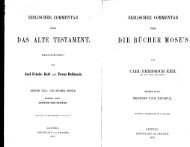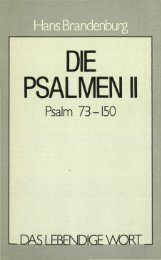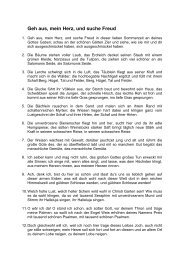Create successful ePaper yourself
Turn your PDF publications into a flip-book with our unique Google optimized e-Paper software.
amplitudes. The pressure exerted by a barely<br />
audible 1,000 Hz tone is 2 x 10 -5 N/m 2 . At the<br />
same frequency the pain threshold is about six<br />
million times greater. The performance of the ear<br />
encompasses several powers of ten (Diagram,<br />
page 23).<br />
A sound at the threshold of audibility causes the<br />
ear drum to vibrate with an amplitude of only<br />
10 -10 cm. We need to use an extraordinary comparison<br />
in order to visualise such a minute displacement.<br />
If our body height were increased by<br />
a factor of 200 million, it would extend from the<br />
earth to the moon. Even at this enormously magnified<br />
scale, the ear drum would only vibrate over<br />
a distance of 2 mm.<br />
The frequency range of the human ear is approximately<br />
10 octaves. One octave comprises the<br />
notes from middle C to C’ (or A to A’, G to G’, etc).<br />
This does not imply absolute values, but indicates<br />
a doubling of the frequency. Two octaves (e. g.<br />
from C to C’’) thus range from a given frequency<br />
f 1 to a frequency f 2 = 4 x f 1 – a fourfold increase.<br />
Similarly three octaves imply an eightfold increase:<br />
f 3 = 2 3 x f 1 . Human hearing ranges over 10 octaves,<br />
from 20 Hz to 20 kHz, involving the factor 2 10 =<br />
1024 = approximately one thousand.<br />
The ability to distinguish between different tones<br />
is astonishingly good. Around a frequency of<br />
1,000 Hz we can detect frequency differences as<br />
small as 3 Hz or 0.3 %.<br />
a)<br />
b)<br />
The zum rim Tunnel of the eingerollte helix is<br />
folded Krempe to der form Helix a tunnel<br />
Sound path 1<br />
Darwinsches Darwin’s<br />
Höckerchen tubercle<br />
Entry to the<br />
Tor tunnel zum<br />
Helixtunnel (flume) of<br />
the helix<br />
Helix<br />
(Schnecke) Helix<br />
Anthelix<br />
Antihelix<br />
(Gegenschnecke)<br />
Concha-Höhle<br />
(Cavum Antihelix conchae)<br />
Wurzel<br />
Crus helicus<br />
der Helix<br />
(Crus helicis)<br />
verdeckte<br />
Partially covered<br />
Öffnung<br />
des<br />
opening<br />
äußeren<br />
of the<br />
Gehörganges<br />
external acoustic<br />
meatus<br />
Ohrdeckel<br />
(Tragus)<br />
Tragus<br />
Antitragus Anti-tragus<br />
Sound path 2<br />
Auricle and sound paths<br />
a) Auricle: Anatomical names of the various parts of<br />
the auricle (outer ear) are shown in the illustration<br />
above left.<br />
b) Possible sound paths: Two possible paths, 1 and 2,<br />
are indicated in the diagram above right:<br />
1 shows the route from the antihelix to the acoustic<br />
meatus (auditory canal), while route 2 follows the<br />
S-shaped curve of the rim of the helix. Route 2 is about<br />
66 mm longer than route 1, so that the time lag is<br />
24<br />
0.2 milliseconds (0.066 m / 330 m/s = 0.0002 seconds).<br />
The result is that the brain has four different sound<br />
inputs from the two ears (it’s as if there were four ears!):<br />
Two of the four are located somewhat higher, and further<br />
out, than the other two. The brain receives the same<br />
signal at four slightly different instants.




